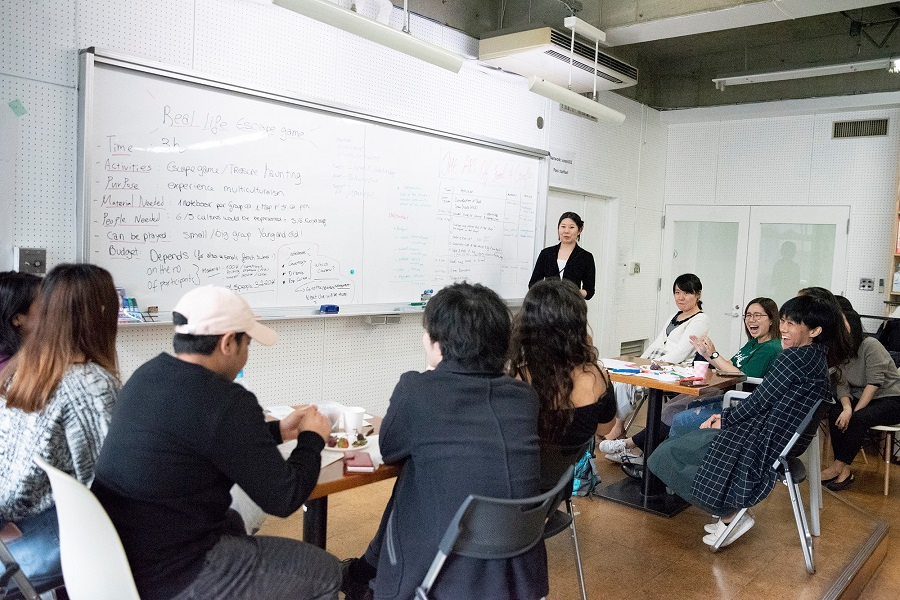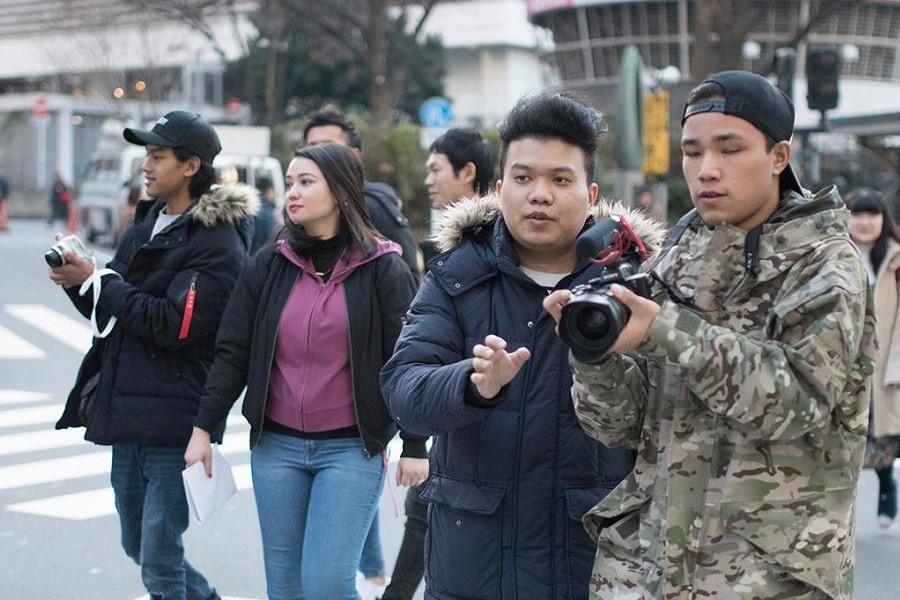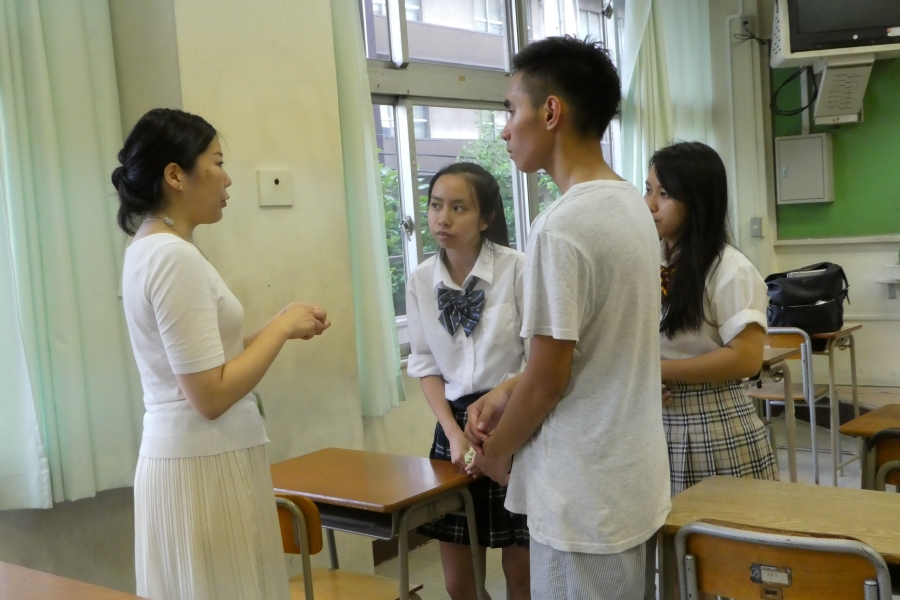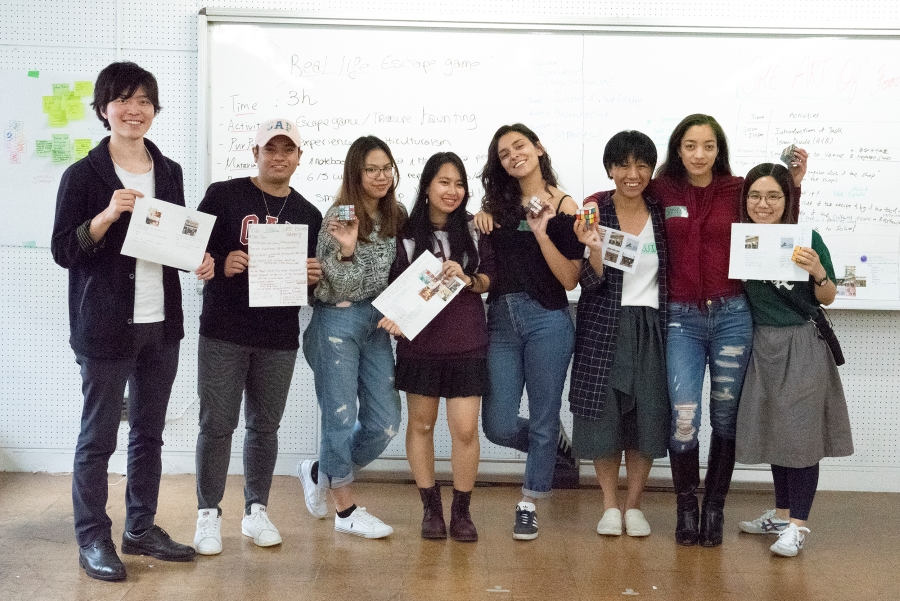Close UP
General Incorporated Association Kuriya Supporting the career development of young people with foreign roots. From art projects to placemaking and policy proposals.

Ms. Shuko Ebihara, the representative director of kuriya, a general incorporated association, stands in front of some youths.
Workshops conducted with artists from Hong Kong and Penang. (Photo: Hiroshi Takaoka)
Among youths with foreign roots living in Japan, those from high school to their early 20s are said to be difficult to reach in order to provide them with support, compared to elementary and junior high school students. kuriya started with creative activities for targeted youth, such as art workshops, including visual arts, photography, dance, music, and other art forms. And, now, kuriya is involved in career education and human resource development projects. We spoke with Ms. Shuko Ebihara, the representative director of kuriya.
Connecting intercultural youth with art; transcending countries, and cultural barriers.

Video workshop organized by foreign youths who participated in kuriya activities.
Ms. Ebihara used to work for the Japan Foundation, an independent administrative institution, where she was involved in international cultural exchange programs. One of the foundation's new projects she worked on in 2009 was the “Shinjuku Art Project,” which lasted till 2013. Ms. Ebihara says she conducted more than 30 art workshops a year for junior high and middle school students with foreign roots, and Japanese junior high and middle school students, including visual arts, photography, dance, and more. Ms. Ebihara explains her motivation for starting the project as follows. “A middle school student with foreign roots once told me, ‘I'm afraid of Japanese kids.’ Some children (with foreign roots) have difficulty making friends even after living in Japan for three or five years. I spent my childhood in Peru and my middle and high school years in England, and it was certainly not easy to make friends even when I learned to speak the language. I thought it would be great (if children with foreign roots and Japanese children) could get to know each other through a shared experience of art.” Leading artists from Japan and abroad, as well as working adults, participated in the workshop which also provided an opportunity for the children to interact with adults. “Why (did) we choose to use art workshops as our project. Art remains a form (a work of art) and allows us to share memories. Even if we couldn't share ‘differences,’ I hoped we could share ‘memories’."
The doubts and limitations felt at the art workshop, so they went on to establish the organization.

“At the beginning of the activity, I think it was based on my own experience. However, in the middle of the program, I began to enjoy interacting with youths, both foreign-rooted and Japanese. I have learned a lot (from the activities). Honestly, I didn't think I would keep doing this for so long, but I found myself enjoying it and doing it for more than 10 years!” says Ms. Ebihara.
While continuing the art project for five years, Ms. Ebihara says that although she received positive feedback for her activities, she began to have doubts and feel limited. “As I got to know the children better at the workshops, they gradually began to be more open to talking to me about their problems. (These are) children with complicated family situations, children who are struggling to make ends meet, children who want to go on to higher education but cannot afford it, and children who have to work to bring money into the family… art cannot solve these problems. Every time I learned about the situations of these children, I wondered if I should continue to offer art workshops.”
To overcome such limitations, Ms. Ebihara shifted toward education and human resource development, incorporating art workshops as an element, and established kuriya in 2016. She says she chose a nonprofit general incorporated association to make it a highly mobile organization. The name of the organization “kuriya” comes from the Chinese character for kitchen. A friend of Ms. Ebihara who has Chinese roots helped her establish the organization, and suggested the name, meaning for, “a place like a kitchen where youths of various backgrounds get together.”
Currently, kuriya is run by four people, including Ms. Ebihara, board members, and staff members. They, as well as have about 30 Pro bono and volunteer workers, participate in the activities on a project basis. Graduates who have participated in the art workshops also come and help as volunteers and staff.
High school, college, and NPO collaborate to create a “place” in an evening high school.

The Betweens Passport Initiative project included activities such as a Multilingual Exchange Club at an evening high school, as well as an internship program for migrant youths, talk events, and other educational activities.
One of BPI’s three projects was a “Multilingual Exchange Club” at the evening school of Tokyo Metropolitan Hitotsubashi High school. Compared to all high school students, high school students with foreign roots have higher rates of high school dropout and non-regular employment, and lower rates of higher education. As for the dropout rate, as of 2018, it was more than seven times higher than the overall high school dropout rate. Under these circumstances, high schools, colleges, and NPOs collaborated to create a place called “club activities,” utilizing the strengths of each and dividing roles among them. The following three objectives were identified for the club activities: (1) a place to connect with friends, teachers, and other adults; (2) a place for high school students to refine their life skills through participation in the creation of activities together; and (3) a place for Japanese students to participate as well, and learn from each other through experiencing diverse cultures and languages. The club activities included relationship building through various activities, and creating a place through exchange programs with international students and artists.
The number of club members has grown from about three at the beginning, to twenty. And, students who have joined the club have successfully graduated from high school and have chosen a career path. And, these students have said to kuriya staff that, in the club activities, they could be themselves, they felt comfortable, and they gained self-confidence.
The challenges that they saw after 10 years of operation, and the limitations of the field.

Ms. Ebihara says that when interacting with youths, she tries to see them as “individuals,” not as “children with foreign roots.” She carefully observes each child during the activities, then tries to assign roles that allow those children to make use of their good points and strength.
“I have been active for 10 years and, as much as I enjoyed it, I gradually felt the limitations in the field. That being said, I realized that the challenges I faced 10 years ago still exist today, 10 years later. There were many frustrating things that I had worked on as solutions to problems but could not change no matter how hard (I tried in) the field. I thought that unless it was established as a system, it would not fundamentally change,” says Ms. Ebihara. In 2018, she also began active policy proposals. “At first, there was no data on dropout rates for high school students with foreign roots. There was no data on career decision rates, either. I started by asking the Ministry of Education, Culture, Sports, Science and Technology, and others, to visualize the issue”. In addition, Ms. Ebihara has made other proposals to eliminate the barriers that high school students and migrant youths encounter, such as dropping out of high school, going to college, and residence status; including switching residence statuses.
Furthermore, as well as establishing a system, she also feels the need to incorporate multicultural support into an existing program for Japanese residents. “The same can be said for the challenges faced by children of foreign origin, and immigrants, as well as other minorities; but it is very difficult for those around them to "personalize" the challenges of others. However, I also feel that if we are the only ones working with foreigners, there will be a limit at some point. I believe that if people who have been working with Japanese nationals are aware of and incorporate multiculturalism and diversity into their activities, they will gradually change.”
Creating an environment where youths are not only seen as the target of support, but also as the bearers of support and active participants themselves.

The youth who participated in workshops and other activities have been actively involved in kuriya's programs as interns and volunteers afterward.
Ms. Ebihara, who has met more than 300 migrant youths through her activities over the past 10 years, is focusing on their potential as she considers the future of multicultural coexistence. Kuriya has adopted an internship structure and works with migrant youths, in their activities. Ms. Ebihara hopes that kuriya will continue to create a place for the next generation to be active, as well as provide a platform for youths to take the next step in their careers.
“I think it is important not only to see migrant youths as targets for assistance but also to create an environment and opportunities for them to play an active role as supporters themselves. The children who have participated in the activities so far have connected with each other, worked together, interacted, and wanted to do their own projects. Each (child) is now at the stage of creating their own career. So, I would like them to use kuriya as an opportunity that leads to their career, work, and future activities.”
Kuriya and Ms. Ebihara have been working closely with youths for many years, seeing them as "migrant youths = future possibilities.” Kuriya will continue to work with migrant youths, toward a society in which they may feel happy to have grown up in Japan.
*This article is based on information available at the time of the interview. For the latest information, please contact the organization directly.
